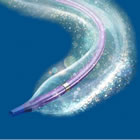Although the concept of angioplasty to open blocked vessels in the legs was first described (and performed) over a half-century ago by Dr. Charles Dotter, percutaneous transluminal angioplasty has seen greater success in the coronary arteries than it has in the peripheral vessels. This may seem counter-intuitive, since the coronary arteries turn and bend, constantly beating back and forth on the surface of the heart, whereas peripheral vessels are long and straight. However, when treating blockages with current drug-eluting stents, restenosis (a.k.a. reblocking) in the coronaries hovers around 5%, but in the superficial femoral artery (SFA) in the upper leg, the restenosis rate can be up to 40%.
The only treatments available once a stent is reblocked are opening the area up with a standard angioplasty balloon, or inserting another stent inside of the blocked one: stent-in-stent. Each of these therapies has drawbacks: the plain old balloon angioplasty (POBA) restenoses more often; the stent-in-stent adds another layer of metal inside the artery.
Enter the drug-coated balloon, a device that combines qualities of both. The DCB expands the blockage, reopening it; deposits a dose of paclitaxel, a drug that inhibits the regrowth of tissue inside the stent; is deflated and withdrawn, leaving no extra device or metal in the newly-opened stent.
One-year outcomes from the IN.PACT Global ISR Imaging Cohort were presented at last year's VIVA meeting: the primary patency rate was 88.7% the clinically-driven target revascularization (CD-TLR) rate was 7.3%, outcomes that begin to approach what has been seen in the coronaries. (At this year's VIVA meeting, which begins September 18, Medtronic will be presenting more analysis of the IN.PACT data, including three-year outcomes of the pivotal IN.PACT SFA trial, and one-year results for the IN.PACT Global Full-Cohort Analysis of real-world challenging and complex lesions.)
The impact of IN.PACT may be substantial because patients who experience in-stent restenosis have not had many options for treatment. They return to the cath lab more often; Dr. Paul Teirstein has referred to these patients as "frequent fliers." Perhaps, for those suffering from peripheral artery disease (PAD) that may be changing.
Medtronic Receives FDA Approval of First Drug-Coated Balloon for Treatment of In-Stent Restenosis (ISR)
IN.PACT Admiral DCB Indication Expansion to Treat Patients with ISR
September 13, 2016 -- Dublin -- Medtronic plc (NYSE: MDT) today announced that the U.S. Food and Drug Administration (FDA) approved the IN.PACT™ Admiral™ drug-coated balloon (DCB) as a treatment for in-stent restenosis (ISR) in patients with peripheral artery disease (PAD). This is the first DCB that has gained approval to treat ISR in the U.S. FDA approval was based on ISR data from the IN.PACT Global Study compared to a standard percutaneous balloon angioplasty (PTA) control.

Dr. John Laird |
"We are experiencing a paradigm shift in treating patients with complex PAD," said John Laird, M.D., interventional cardiologist at U.C. Davis Medical Center and co-principal investigator for the IN.PACT SFA Trial. "Until now physicians have had limited treatment options to address patients with ISR. The FDA's approval of IN.PACT Admiral DCB allows us to treat patients with a durable, proven, and safe technology."
ISR occurs when a stent is placed in the artery to restore blood flow but over time plaque can form in and around the stent. This condition is estimated to occur in up to 40 percent of all stents placed in the superficial femoral artery (SFA).[1],[2]
"Prior to the FDA approval of IN.PACT Admiral DCB for ISR, physicians were challenged to find a durable treatment for PAD patients, considering the complexity of the disease," said Mark Pacyna, vice president and general manager of the Peripheral business, which is part of the Aortic & Peripheral Vascular division at Medtronic. "Together, in collaboration with physicians in the vascular clinical community, we designed the IN.PACT Global Study to look at challenging lesions in real-world patients. Today, the IN.PACT Admiral DCB has demonstrated consistent outcomes across all patient morphologies, and it is the only DCB approved to treat patients with ISR in the U.S."
Real-world data from the IN.PACT Global Study demonstrating safe and effective treatment of complex ISR lesions was first presented on the scientific podium at VIVA 2015. The one-year primary patency rate for this difficult to treat patient subgroup in the IN.PACT Global ISR Imaging Cohort was 88.7 percent, and the clinically-driven target revascularization (CD-TLR) rate was 7.3 percent. The mean length of lesions was 17.2 ± 10.5 cm, with 34.0 percent occluded ISR lesions. Additional ISR data from the IN.PACT Global Study and a PTA control were used to gain FDA approval of the ISR indication.
About IN.PACT Admiral Drug-Coated Balloon
The IN.PACT Admiral drug-coated balloon is a clinically-proven, cost-effective primary endovascular therapy that enables physicians to treat claudication and restenosis for patients with superficial femoral artery (SFA) disease. The DCB's primary mode of action is physical dilatation of the vessel lumen by PTA, and the proven paclitaxel drug is intended to prevent artery narrowing by minimizing scar tissue formation.
IN.PACT Admiral DCB received the CE (Conformité Européene) Mark in 2009 to treat PAD and was approved by the U.S. Food & Drug Administration in December 2014 to treat superficial femoral and popliteal arteries. It has been studied in more than 20 individual clinical trials demonstrating durable safety and clinical benefits. To date, more than 150,000 patients have been treated with IN.PACT Admiral DCB.
In collaboration with leading clinicians, researchers, and scientists worldwide, Medtronic offers the broadest range of innovative medical technology for the interventional and surgical treatment of cardiovascular disease and cardiac arrhythmias. The company strives to offer products and services of the highest quality that deliver clinical and economic value to healthcare consumers and providers around the world.
About Medtronic
Medtronic plc (www.medtronic.com), headquartered in Dublin, Ireland, is among the world's largest medical technology, services and solutions companies - alleviating pain, restoring health and extending life for millions of people around the world. Medtronic employs more than 88,000 people worldwide, serving physicians, hospitals and patients in approximately 160 countries. The company is focused on collaborating with stakeholders around the world to take healthcare Further, Together.
Any forward-looking statements are subject to risks and uncertainties such as those described in Medtronic's periodic reports on file with the Securities and Exchange Commission. Actual results may differ materially from anticipated results.
[1] Laird, J.R., et al., Nitinol stent implantation versus balloon angioplasty for lesions in the superficial femoral artery and proximal popliteal artery: twelve-month results from the RESILIENT randomized trial. Circ Cardiovasc Interv, 2010. 3(3): p. 267-76.
[2] Armstrong, E.J., et al., Nitinol self-expanding stents vs. balloon angioplasty for very long femoropopliteal lesions. J Endovasc Ther, 2014. 21(1): p. 34-43.


